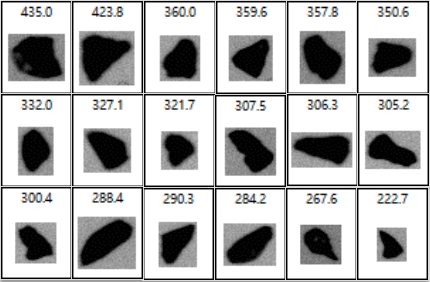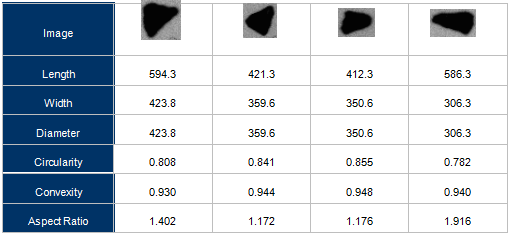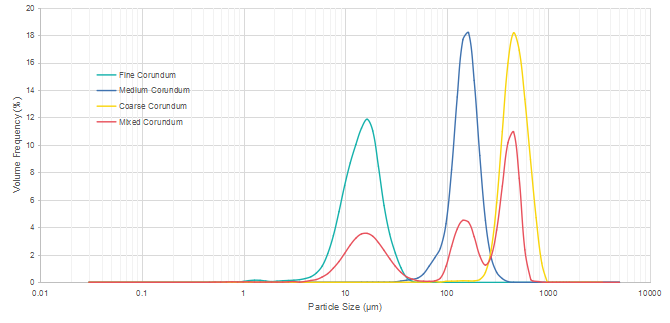An abrasive is a material that is used to cut, grind and polish other softer materials. With the capability to reduce a surface by friction and rubbing, abrasives are utilized in a wide range of domestic, industrial, and technological applications, giving rise to a large variation in the particle size and shape of the abrasive materials. Abrasives find use in all facets of life from the sandpaper a carpenter uses to make the wood smoother to abrasive polishes that make an expensive shiny finish for a car.
This example below shows a study on characterizing abrasives by using the measurement of laser diffraction with simultaneous dynamic image analysis.
Three corundum abrasive powder samples, fine, medium and coarse were measured by the Bettersizer S3 Plus to characterize both the particle size and shape. Here we demonstrate how these powders differ in size as well as how they compare in their shape parameters.
Figure 1. Particle size cumulative volume curves of fine, medium, coarse corundum powders using the combination technique
Table 1. Critical parameters for characterizing the abrasive powders in figure 4
As shown in Figure 1, after the characterization of three different grits of abrasive powder samples, particle size results rank in the correct order as we would expect. It can be predicted that coarser particles will have a higher impact force and therefore remove the material surface quicker producing a heavier texture.
Interestingly, despite of the different sizes of the three abrasive powders, their circularity is significantly uniform, as shown in Table 1, thus confirming the grinding process of the manufacturer for these abrasive powders is very well under control.
In addition, with dynamic image analysis technique based on counting, the Bettersizer S3 Plus is capable of easily identifying overly large or too spherical grains individually or indeed by viewing all the size and shape data parameters of all the particles creating number-based distribution and multiple other parameters. Figure 2 shows several camera images of a coarse abrasive powder captured by the Bettersizer S3 Plus in detail. The number shown above the image is the particular diameter selected by the user (Feret width or Feret length etc.) for each particle.
Figure 2. Camera images extracted from the individual particle list of a coarse abrasive powder (between about 500 and 200 µm)
Table 2. Critical shape parameters of some large particles contained in a coarse abrasive powder
Size distribution is of primary interest, but a single size measurement is not adequate since the abrasive particles are not round and as is shown in Table 2, length and width are needed, as well as the circularity.
One of the primary shape parameters generated by the Bettersizer S3 Plus is circularity. The more spherical the particle, the closer its circularity approaches 1. The more elongated the particle, the lower its circularity. All of the selected shape parameters were able to offer information about abrasive morphology. Thus, measurements from the Bettersizer S3 Plus have enabled a more precise way of characterizing different particle shapes, and differences in shape between otherwise similar products.
Finally, a new sample was mixed from fine, medium, and coarse samples for demonstration purposes. The particle size distribution of four samples including the mix are shown in Figure 3. The analysis of that mixture indicates the presence of the three original materials as to be expected and consequently, the high-resolution capability of the combination technique is verified as well.
Figure 3. Particle size distribution comparison of fine, medium, coarse and mixed abrasive powders
Conclusion
The study has demonstrated that the Bettersizer S3 Plus is able to characterize the size and shape of the abrasives simultaneously and provide much more information than conventional laser diffraction analyzers.









